Alfa Romeo Giulia TI repeats its grand entrance
By John Gilbert
At the world-wide introduction of the Alfa Romeo Giulia, I had the good fortune to be among the assembled journalists summoned to Milano, Italy — Milan, to those who haven’t been there — when it was rolled out on stage. World-famous Italian tenor Andre Bocelli strolled on stage with it, serenading the room with a spectacular love song and putting the whole scenario over the top as a highly emotional event.
Those Italians know how to do emotion. Their magic is how they transform that quality into their cars!
Over the succeeding year, and numerous stops and starts that delayed the Giulia from reaching U.S. showrooms, it has finally made it. I’ve already written about the follow-up Stelvio, Alfa’s companion and the company’s first SUV, based on the Giulia.
Finally, I got to get bucket-seated inside a Giulia TI painted “Rosso Competzione Tri-Coat” red, to drive home from Chicago to Duluth, Minnesota. The wait was easily worth the reward.
I’ve always tried to suppress the hyperbole and press-release cliches when I write about cars, even though the bar has been raised so high by the always-improving new crop of vehicles, and so few deserve criticism nowadays. But restraining my impressions of the Giulia is more difficult, if not impossible.
Let’s start off by explaining that many of my friends have asked me, over the years, “OK, you drive new cars every week; what is your favorite of all time?” I always have checked my bet and explained that I have favorites in every style and type of vehicle, and in every price range, and here are a half-dozen…
Now I don’t have to hesitate. The Alfa Romeo Giulia TI is, without a doubt, my favorite car from the vast 50-year array of new cars I’ve driven.
The Giulia comes in two fashions. Both start with the same high-strength-steel body and an amazingly smooth platform that is firm anough to allow it to snake around the tightest turns with flat poise and yet with a grace that is never harsh. Italian cars seem to have the inside track on building cars that combine being beautiful and sensual, and the same goes for their engines. In this case, Fiat — which owns Alfa Romeo, Ferrari, Maserati, and Ferrari Formula 1 racing enterprises — was taking no chances with a built-from-scratch sedan intended to set new and iconic standards when exported to America.
Legend has it that Fiat executives selected two Ferrari Formula 1 race engineers, told them to chose a team of engineers, and then design and build two extremely high-tech engines, a four and a V6, to power the Giulia. With its flawless and striking design and perfect front-rear balance, the Giulia was only in need of powertrains to match.
The basic Giulia comes with a 2.0-liter 4-cylinder Turbo engine with 280 horsepower and 306 foot-pounds of torque, operating through an 8-speed automatic transmission shiftable by hand with long and sleek aluminum paddles. Those paddles are affixed to the steering column, not the steering wheel, which is beneficial for keeping the paddles within readily accessible placement, always where the driver can anticipate them, with the right side to upshift and left to downshift.
The costlier Giulia Quadrifoglio comes with a 2.9-liter V6, twin-turbocharged, producing 505 horsepower and 443 foot-pounds, available with a 6-speed stick. The Quadrifoglio, which means cloverleaf in Italian, hence the cloverleaf logo for Alfa, costs about $70,000. We won’t question how easily worth it the car is.
The 4-cylinder, however, is the prize, in my opinion. It also has front-engine/rear-drive, but can be bought with Alfa’s specific all-wheel drive system, and it has a base price of $39,995, which means for about $45,000, you could get a Giulia with all-wheel drive. That’s the one I want, the better to scale Duluth’s clifflike avenues, if not twisting roadways in the Italian Alps.
I got the chance to drive both models briefly at Autobahn Country Club in Joliet, Ill., both on the track and on surrounding roadways. Both models left me completely unable to pick which feature I liked best: the striking exterior design, the supple leather and aluminum interior, the fantastic power and performance, or the incredible quick-response steering and handling. After too-few short days living with the Giulia, I decided that all those assets combined in glorious harmony make the whole package so alluring, but as good as it looks, accelerates, and sounds, the most amazing single feature is the handling.
I can’t think of an exotic sports car that handles any better. In real-world driving, the reality is that any car that handles as well as the Giulia, also has superb emergency evasive-handling ability. A confused deer dashes out in your path, or some texting driver thoughtlessly runs a stop sign on an approaching cross street, then your driving abilities go on red alert, and the Alfa Romeo Giulia is the ideal tool to act out your instincts.
When we left Chicago to drive home, and were notified that we would get the dark red Giulia instead of the gleaming white Quadrifoglio, I was happy. First, my wife, Joan, loves red cars and this Italian red would blow her socks off. It was mid-afternoon, and we weren’t as far as Rockford, Ill., when the sun was setting, but the Giulia, with its firmly bolstered bucket seats and room for four, was computer-perfect in its road manners.
My son, Jack, who also assists me with New Car Picks stuff, drove his share on the way home, and declared it the best car he’d driven, ever. I dropped him off where he’d left his car at a friend’s, near Chippewa Falls, Wis., and got back on the highway headed north, to Duluth. I only saw one deer, and it stayed respectfully on the shoulder, possibly keeping its distance from the brilliant white glare of the perfectly tuned automatic headlights. I arrived home at 3 a.m., tired, but still exhilarated from driving, without a trace of fatigue.
Joan’s work schedule, and my sneakiness, kept her from jumping in the Giulia and disappearing over the horizon. Although, she conceded, she considered it. I asked what she thought was the Giulia’s best feature.
“The looks; it’s the most beautifully designed car I’ve ever seen,” she said. “It’s a work of art. It looks like it’s moving when it’s standing still. It flows, and it’s so emotional. It’s almost like you don’t take it for a drive, it takes you for the drive. You feel as though you could take it out on a race track, win the race, and then enjoy driving it home.”
Guess I didn’t have to be shy about the superlatives. The rounded nose, with the distinctive shield-shaped grille with the Alfa badge festooned on it, means the car could never be mistaken for another nameplate. The rear seats easily fit two, and the trunk is surprisingly large.
The Giulia stops pedestrians in their tracks. Joan and I drove it up onto Skyline Drive, high above Duluth, looking down on the harbor. As soon as we stopped and got out, a group of motorcyclists on sports-bikes, not Harleys, arrived and lined up behind the Giulia, in a formation lineup for some group photos. Many of them walked over first to inquire and praise the Giulia. It would have made a fantastic ad for the Giulia to start up and drive along that curvy cliff-top road, with a swarm of beautiful, lean sports-bikes swarming like respectful bees for an escort.
We got a chance on Sunday to drive 100 miles amid the stunning fall foliage into Wisconsin to attend the annual Bayfield Apple Festival. Great time, great crowd, every imaginable thing made out of apples, and a perfect 60-degree fall day with bright blue sky and golden leaves.
Because Bayfield is located on mostly two-lane roadways, some winding along the South Shore of Lake Superior, you don’t drive over the speed limit, especially noting the affinity Wisconsin police have for out-of-state contributions to local coffers. Keeping the Alfa under 70 was a worthy challenge. It also allowed me to fill the tank for the trip with super 91-octane premium Mobil, drive down and back for a 200-mile total, and still have three-fourths of a tank left. It computed to 39.0 miles per gallon. High-mileage driving never felt so impressive.
The test car had a base price of $39,995 and as-tested sticker at $51,990. The test car had front-engine/rear-wheel drive, and its extremely quick power-steering may have benefitted from that. But the 4-cylinder can add all-wheel drive for about $1,500 more, and I’d trade a few of the finer options for the AWD unit. Let’s see how it take the hills in Duluth in January, with a set of Nokians mounted on those 19-inch aluminum wheels.
Needless to say, when the opportunity arrives to spend a few days with the Quadrifoglio and its sizzling-hot V6, I will jump at the chance, even if it doesn’t have an AWD version. Earlier this year, both Motor Trend and Car and Driver magazines conducted thorough comparison tests, with all their fancy testing protocol, and I read both with considerable interest. Both of those magazines can occasionally get pretty full of themselves and might let it spill over in the quest to satisfy a major advertising account. The only place I disagreed with their deductions this time was when they kissed off the 2.0-liter 4 as being too shy on power, which is definitly not true, in my view
Their findings were surprisingly similar, both taking a 505-horsepower Giulia Quadrifoglio to run against the perceived best compact luxury sport sedans.
Motor Trend tested the Mercedes Benz C300 Sport, Lexus IS 200t F-Sport, Jaguar XE 25t Prestige, Cadillac ATS 2.0t turbo, Audi A4 2.0 quattro (although both magazines insist on writing it “Quattro” with a capital Q, despite the manufacturer’s pleas), and the Alfa Romeo Giulia Quadrifoglio. Combining all the features, Motor Trend ranked them: 1. Alfa, 2. Audi A4, 3. Mercedes, 4. Lexus IS, 5, Cadillac ATS, and 6. Jaguar.
Motor Trend then brought back the top four high-performers and ran their hot-rod upgraded versions through another battery of tests and ranked them, counting down: 4. Mercedes AMG63, 3. Cadillac ATS-V, 2. BMW M3 Competition Package, and 1. Alfa Romeo Giulia Quadrifoglio. Remarkable that the car beat all the best luxury-sport sedans, as well as the top specialty upgrade models.
Car and Driver assembled what it had tested as the hottest four sport-luxury sedans, and ranked them for acceleration, chassis, driveline, etc. They drove all four for 1,100 miles across Death Valley, and then gave points in each category. The results came out: 4. Cadillac ATS-V, 3. BMW M3, 2. Mercedes AMG C63 S (with 503 horsepower V8), and 1. Alfa Giulia Quadrifoglio.
It would be even more interesting if the two magazines humbled themselves to retest the 4-cylinder version against other 4-cylinder cars in that class, costing around $40,000, or half the price of the hotter models. My suspicion is the Alfa would win by an even greater margin.
On the other hand, maybe it’s better to let the masses seek the V6 model, at $75,000, and we can keep the $45,000 Giulia TI a secret while we start selling off assets and hold garage sales to summon up the required cash.


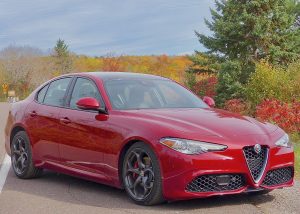
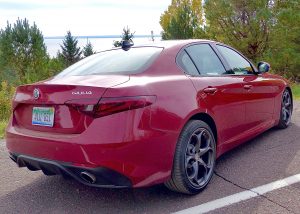
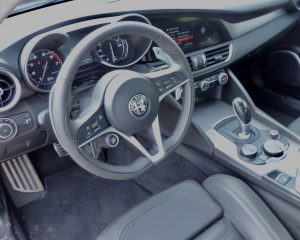
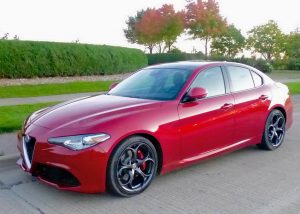
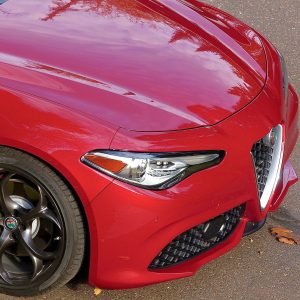
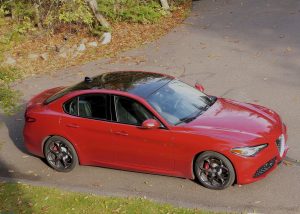
 John Gilbert is a lifetime Minnesotan and career journalist, specializing in cars and sports during and since spending 30 years at the Minneapolis Tribune, now the Star Tribune. More recently, he has continued translating the high-tech world of autos and sharing his passionate insights as a freelance writer/photographer/broadcaster. A member of the prestigious North American Car and Truck of the Year jury since 1993. John can be heard Monday-Friday from 9-11am on 610 KDAL(www.kdal610.com) on the "John Gilbert Show," and writes a column in the Duluth Reader.
John Gilbert is a lifetime Minnesotan and career journalist, specializing in cars and sports during and since spending 30 years at the Minneapolis Tribune, now the Star Tribune. More recently, he has continued translating the high-tech world of autos and sharing his passionate insights as a freelance writer/photographer/broadcaster. A member of the prestigious North American Car and Truck of the Year jury since 1993. John can be heard Monday-Friday from 9-11am on 610 KDAL(www.kdal610.com) on the "John Gilbert Show," and writes a column in the Duluth Reader.